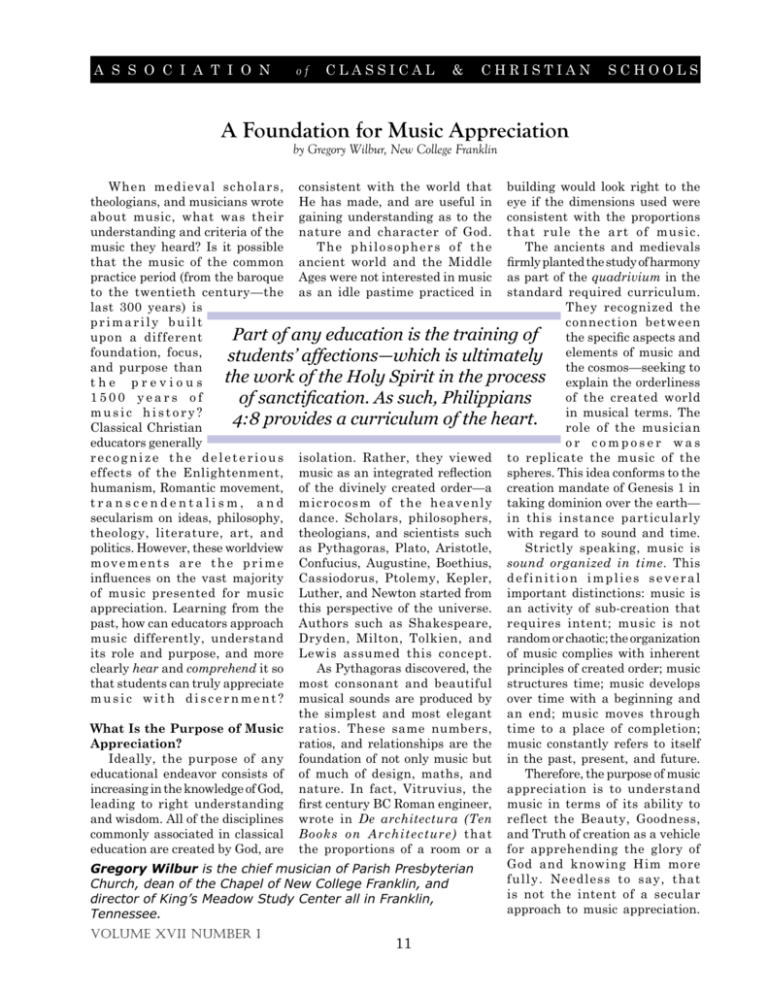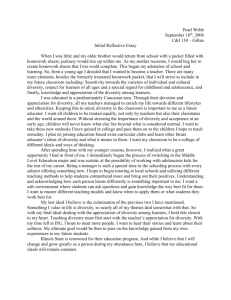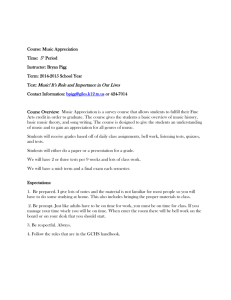A Foundation for Music Appreciation
advertisement

A ssociation of C lassical & C hristian S chools A Foundation for Music Appreciation by Gregory Wilbur, New College Franklin When medieval scholars, consistent with the world that building would look right to the theologians, and musicians wrote He has made, and are useful in eye if the dimensions used were about music, what was their gaining understanding as to the consistent with the proportions understanding and criteria of the nature and character of God. that rule the art of music. music they heard? Is it possible The philosophers of the The ancients and medievals that the music of the common ancient world and the Middle firmly planted the study of harmony practice period (from the baroque Ages were not interested in music as part of the quadrivium in the to the twentieth century—the as an idle pastime practiced in standard required curriculum. last 300 years) is They recognized the primarily built connection between Part of any education is the training of upon a different the specific aspects and foundation, focus, students’ affections—which is ultimately elements of music and and purpose than the cosmos—seeking to the work of the Holy Spirit in the process explain the orderliness the previous 1500 years of of the created world of sanctification. As such, Philippians music history? in musical terms. The 4:8 provides a curriculum of the heart. Classical Christian role of the musician educators generally or composer was r e c o g n i z e t h e d e l e t e r i o u s isolation. Rather, they viewed to replicate the music of the effects of the Enlightenment, music as an integrated reflection spheres. This idea conforms to the humanism, Romantic movement, of the divinely created order—a creation mandate of Genesis 1 in t r a n s c e n d e n t a l i s m , a n d m i c r o c o s m o f t h e h e a v e n l y taking dominion over the earth— secularism on ideas, philosophy, dance. Scholars, philosophers, in this instance particularly theology, literature, art, and theologians, and scientists such with regard to sound and time. politics. However, these worldview as Pythagoras, Plato, Aristotle, Strictly speaking, music is m o v e m e n t s a r e t h e p r i m e Confucius, Augustine, Boethius, sound organized in time. This influences on the vast majority Cassiodorus, Ptolemy, Kepler, d e f i n i t i o n i m p l i e s s e v e r a l of music presented for music Luther, and Newton started from important distinctions: music is appreciation. Learning from the this perspective of the universe. an activity of sub-creation that past, how can educators approach Authors such as Shakespeare, requires intent; music is not music differently, understand Dryden, Milton, Tolkien, and random or chaotic; the organization its role and purpose, and more Lewis assumed this concept. of music complies with inherent clearly hear and comprehend it so As Pythagoras discovered, the principles of created order; music that students can truly appreciate most consonant and beautiful structures time; music develops m u s i c w i t h d i s c e r n m e n t ? musical sounds are produced by over time with a beginning and the simplest and most elegant an end; music moves through What Is the Purpose of Music ratios. These same numbers, time to a place of completion; Appreciation? ratios, and relationships are the music constantly refers to itself Ideally, the purpose of any foundation of not only music but in the past, present, and future. educational endeavor consists of of much of design, maths, and Therefore, the purpose of music increasing in the knowledge of God, nature. In fact, Vitruvius, the appreciation is to understand leading to right understanding first century BC Roman engineer, music in terms of its ability to and wisdom. All of the disciplines wrote in De architectura (Ten reflect the Beauty, Goodness, commonly associated in classical Books on Architecture) that and Truth of creation as a vehicle education are created by God, are the proportions of a room or a for apprehending the glory of God and knowing Him more Gregory Wilbur is the chief musician of Parish Presbyterian fully. Needless to say, that Church, dean of the Chapel of New College Franklin, and is not the intent of a secular director of King’s Meadow Study Center all in Franklin, approach to music appreciation. Tennessee. Volume XVII Number 1 11 A ssociation of C lassical & C hristian S chools A Foundation for Music Appreciation… During the Enlightenment, the search for, and attempted replication of, cosmic order was displaced by a desire for music that appealed to individuals, was less formal, embraced natural religion, was nonmetaphysical, and progressive. It is this concept that has unfortunately prevailed to our day. Musical Elements or How to Appreciate Because of the order of the cosmos, balance and order resonate in the human spirit more clearly than chaos. For instance, a perfectly drawn circle has a beauty and unity that is lacking if the line gets squiggly or flattens the arc. This is also why listeners are not drawn towards atonal or chance (aleatoric) music—there is no sense of order, development, or completion. Conversely, despite the beauty of the cosmos, the Fall affects the desire to seek out those things that are true, lovely, and of good report. Consequently, it is easier to listen to music that requires no thought, that provokes immediate emotional reactions, and makes no disciplined demands. This is why educators should continually set before their students objectively good examples—whether that means music, literature, geometric proofs or dissected frogs—and provide the means to comprehend Truth and Beauty in the framework of a Christian worldview. Melody and rhythm— representing sound and time— are the primary elements of music with harmony, tone color, structure, etc. as subsets. In addition to specifically exploring how well these elements fulfill their inherent potential and conform to God’s created order, there are a few other areas to bear in mind—such as the type, or kind, of music with regard to its context and purpose, use of voices and/or instruments, and the horizontal or vertical nature of the melody and harmony. Principles of Listening or When to Appreciate In addition, the following principles should also govern how and when we present music for the sake of appreciation. Firstly, music should be treated as music and not as a soundtrack or literary narrative. The same issue exists in art appreciation—the subject of a painting often takes precedence over the idiomatic elements of the work such as use of color, contrast, balance, perspective, brush strokes, etc. Likewise, educators turn music into a background for narrative expression (draw a picture of what this music sounds like to you) instead of the more difficult labor of teaching the elements of music. The most sensual music is not always the best music— which is why Tchaikovsky is not as good of a composer as Brahms. Secondly, listening to music must be an active and not passive activity. Students should know how to use musical scores or portions of scores and how to sing or play instruments. In learning a piece of music, they should taste the music from the inside out by playing or singing parts of the melody to actively connect with the notes and their relationships. Thirdly, the elements of music should be built up over time. There is no reason for students not to enjoy and savor and dissect good melody over the period of several years of study. This will create a vocabulary, or grammar, of music to be used later on. Without this foundation, students are easily 12 13 lost in a great work of music as if they had been thrown into Hamlet without the benefit of learning parts of speech so that the sentences are nonsensical. Fourthly, music can be, and should be, connected to the rest of the student’s studies either historically or thematically. Thematic connections can provide a touch point between various disciplines. For example, when reading the book of Exodus, also study Israel in Egypt by G.F. Handel for an aural representation of the plagues on the Egyptians and deliverance of God’s people. In addition, when studying the Middle Ages and the Renaissance, what better time is there to dive into the parts of the mass (all Biblical texts), the development and codification of plainsong chant, the rise of polyphony, and the glorious liturgical music of Machaut, Dufay, Josquin, Palestrina, Tallis and Byrd? Consequently, as students learn about the ideas and philosophies of the day, they can see how these ideas were practically worked out in the music and art of its day. And this leads, fifthly, to making sure that the music included for appreciation extends beyond the common practice period to include such types as liturgical music, chant, vocal polyphony, and folk music as well as others. With a primary focus on melody, young students can quickly engage with good music through learning to sing (preferably by means of solfège) and through studying chant, folk songs, and other beautiful melodies. The time to inculcate students with an integrated love of music and song is when they are young. As students get older and have mastered foundations of music, spring 2010 A ssociation of C lassical & C hristian S chools A Foundation for Music Appreciation… then the thematic and historic study of music, as mentioned above, readily connects music to their other studies. This also enables the exploration of music history in the context in which it occurred. With regard to frequency, as an integrated and necessary part of the curriculum, music should be returned to its rightful place of equality with the other disciplines. Music appreciation, music making, reading skills, and theory should form a regular part of the daily class schedule—or at least as frequently as math, science, or Latin. Guide for Selection or What to Appreciate God calls His people to worship Him in Spirit and Truth and to do so skillfully. In cultivating worshippers, instruction in music—in order to worship skillfully and with discernment— becomes as necessary as teaching someone to read that they may understand God’s Word. Music orders the mind, strengthens the heart, and soothes the spirit. As such, music has historically held a prominent and integrated role in curricula. Music instruction is not enrichment, extracurricular, or optional but a core component of the path to wisdom. —Gregory Wilbur, Statement on Philosophy of Music Education Part of any education is the training of students’ affections— which is ultimately the work of the Holy Spirit in the process of sanctification. As such, Philippians 4:8 provides a curriculum of the heart. When we replace the idea of music appreciation with cultural enrichment, the study of music becomes a far different thing. Training affections to apprehend the reflected Beauty, Goodness, and Truth of God’s creation moves students to the point of thinking about and understanding God’s nature and character. We must not lightly ignore the wisdom of the church fathers and medieval scholastics—the democracy of the dead—with regard to the seven integrated liberal arts. This approach to understanding music fashioned 1000 years of plainsong and developed composers such as Palestrina, Schütz, Handel, and Bach. The end goal of music appreciation, and music studies in general, is to develop discerning and active worshippers. Students will always hear music around them, but giving them the tools to actually listen and evaluate what they hear reveals the bounty and goodness of our Creator who has given such wonderful gifts to His children. Consequently, as our hearts respond in worship, we should desire to only bring the best as a sacrifice of praise— that includes music as ordained by God, not what we prefer. This desire can only be achieved by submitting ourselves to the tutelage of God’s instruction in His Word and the manifestation of His glory in His creation in order to truly understand and appreciate music aright. NOTE: This article is an excerpt from a paper detailing more specifics about music appreciation that will be presented at the Classical Christian Fine Arts Symposium in Lancaster, PA, in March 2010. From the Dark Woods to the Light by G. Tyler Fischer Selva obscura . . . so begins one of the greatest books. It begins in a dark woods with a lost, middleaged man. How lost was he? He was so lost that it would have been fruitless to preach the gospel to him. He was not listening. He had lost sight of the Truth. This man was the poet Dante. As he is confronted by his sin and finds himself powerless in the dark woods, he has one thing in his favor: others are looking out for him. Others are sending him help. Who would you send to win the heart of a man lost in darkness? A preacher? A theologian? A saintly man or woman? He would not have listened! God does not send a philosopher or a minister to Dante, instead He sends a pagan artist—another poet who stirs the G. Tyler Fischer has been the headmaster at Veritas Academy in Leola, PA, since 1997 and is a member of the ACCS Board. See http://www.veritasacademy.com/. Volume XVII Number 1 13 heart of the wayward Christian to long for more—to long for true beauty. As Dante languishes in the woods he sees a ghost and he cries out for help. The shade turns out to be the poet Virgil— the greatest of Latin poets. Virgil is one of the greatest characters of The Comedy. He symbolizes human reason and serves as Dante’s guide bringing him almost to Heaven. In the poem, he also is simply what he is. Virgil is a poet and his poetry calls Dante to again look up—above himself and






